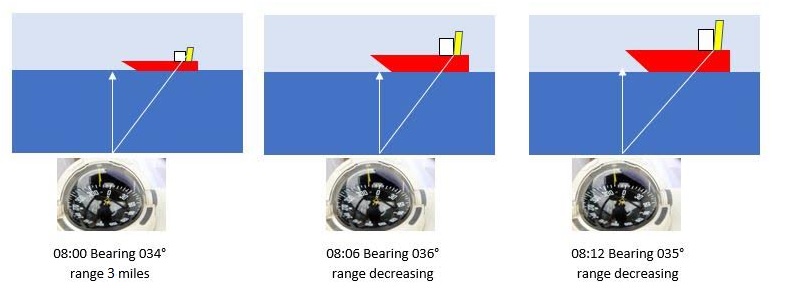Explanation Rule 7
Taking compass bearings is one of the most important means of determining risk of collision. Good visibility is needed to use this technique and a series or number of bearings need to be taken. On smaller vessels bearings may be taken using a hand-bearing compass, on larger vessels, a bearing or azimuth ring is used.
In restricted visibility, the primary tracking instrument is radar, if fitted and operational. Radar should also be used to track a vessel in good visibility in open areas after the vessel has been sighted visually. On vessels fitted with two radars it may be advantageous to use relative motion display on one radar and true motion display on the other
All available means includes the use of the above techniques plus the use of VHF, visual look-out etc, When using VHF it should be borne in mind the problems of identification and communication and that valuable time may be wasted in attempting to make radio contact instead of concentrating on the assessment of collision risk and the need for action.
Automatic identification systems (AIS) are now being fitted to vessels, in accordance with the carriage requirements of the Safety of Life at Sea Convention (SOLAS). It should be remembered that not all vessels carry AIS.
Collision avoidance must be carried out in strict compliance with the COLREG. There is no provision in the COLREG for use of AIS information, therefore, decisions should be taken based primarily on systematic visual and/or radar observations. The availability and display of AIS data similar to one produced by systematic radar target tracking (e.g. automatic radar plotting or tracking aid (ARPA, ATA)) should not be given priority over the latter. AIS target data will only be based on the target vessels’ course and speed over ground whilst for COLREG compliance such data must be based on the vessels’ course and speed through the water. See MGN 324 Amendment 1 for further information.
The Rules do not state what risk of collision is or when it exists. Risk of collision exists when two vessels are following courses that would take them to the same position in a few minutes. Risk of collision would NOT exist for two slow-moving vessels 16 miles apart heading for the same position.
A definition of when the Regulations apply for risk of collision is, “They only apply at a time, when, if either of them does anything contrary to the Regulations, it will cause danger of collision. None of the Regulations apply unless that period of time has arrived. It follows that anything done before the time arrives at which the Regulations apply is immaterial, because anything done before that time cannot produce risk of collision within the meaning of the Regulations”. (Lord Esher, 1887)
When determining risk of collision a number of factors are involved:
- Closest distance of approach
- Type of waterway
- Vessel size and manoeuvrability
- Speed
- Distance out from closest point of approach
- Relative bearing
Rule 7
Risk of collision.
(a) Every vessel shall use all available means appropriate to the prevailing circumstances and conditions to determine if risk of collision exists. If there as any doubt such risk shall be deemed to exist.
(b) Proper use shall be made of radar equipment if fitted and operational, including long-range scanning to obtain early warning of risk of collision and radar plotting or equivalent systematic observations of detected objects.
(c) Assumptions shall not be made on the basis of scanty information, especially scanty radar information.
(d) In determining if risk of collision exists the following considerations shall be among those taken into account.
(i) such risk shall be deemed to exist it the compass bearing of an approaching vessel does not appreciably change.
(ii) such risk may sometimes exist even when an appreciable bearing change is evident, particularly when approaching a very large vessel or a tow or when approaching a vessel at close range.
